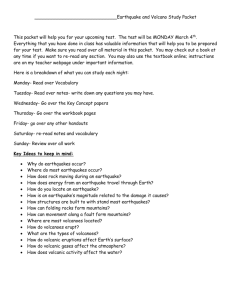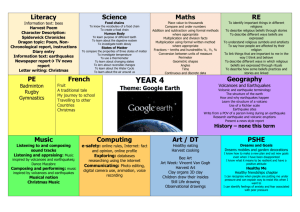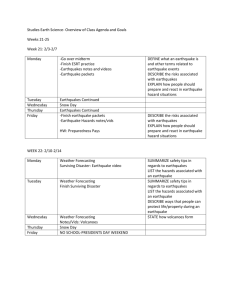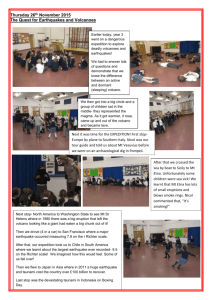Hazards Major External Processes
advertisement
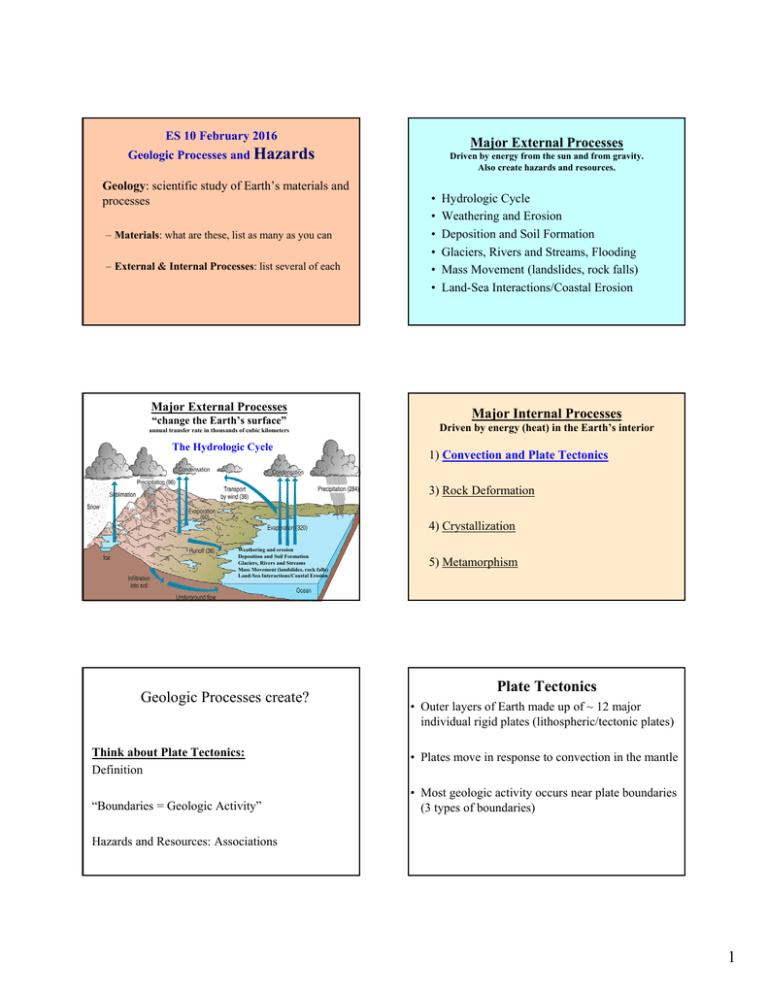
ES 10 February 2016 Major External Processes Geologic Processes and Hazards Geology: scientific study of Earth’s materials and processes – Materials: what are these, list as many as you can – External & Internal Processes: list several of each Major External Processes “change the Earth’s surface” annual transfer rate in thousands of cubic kilometers The Hydrologic Cycle Driven by energy from the sun and from gravity. Also create hazards and resources. • • • • • • Hydrologic Cycle Weathering and Erosion Deposition and Soil Formation Glaciers, Rivers and Streams, Flooding Mass Movement (landslides, rock falls) Land-Sea Interactions/Coastal Erosion Major Internal Processes Driven by energy (heat) in the Earth’s interior 1) Convection and Plate Tectonics 3) Rock Deformation 4) Crystallization Weathering and erosion Deposition and Soil Formation Glaciers, Rivers and Streams Mass Movement (landslides, rock falls) Land-Sea Interactions/Coastal Erosion Geologic Processes create? 5) Metamorphism Plate Tectonics • Outer layers of Earth made up of ~ 12 major individual rigid plates (lithospheric/tectonic plates) Think about Plate Tectonics: Definition • Plates move in response to convection in the mantle “Boundaries = Geologic Activity” • Most geologic activity occurs near plate boundaries (3 types of boundaries) Hazards and Resources: Associations 1 Transform Boundary Divergent Boundaries example: San Andreas Fault Sea Floor Spreading on Oceanic Ridges Typically shallow focus and small earthquakes Convergent Boundaries Subduction @ deep sea trenches, shallow to deep focus earthquakes WEB LINK: http://pubs.usgs.gov/gip/dynamic/understanding.html Geologic Hazards Result from a combination of internal and external processes. Examples include? 1. 2. 3. 4. 5. Earthquakes Tsunamis Volcanoes Mass Movement Coastal Erosion / Flooding / Rising Sea Level 6. Fluvial Systems /Flooding (Later in the Course) 2 Earthquakes Over a million fatalities from earthquakes in the last 10 years. What are the hazards / outcomes? Ground Shaking: landslides, liquefaction, land subsidence, buildings, roads, bridges collapse Fire: broken gas and power lines Flooding: tsunamis and/or “co-seismic subsidence” Ground Displacement: structures lying across fault aka Hypocenter Major dangers are from human-made structures rather than the earthquake itself. http://en.wikipedia.org/wiki/List_of_21st_century_earthquakes# Types of Earthquake Waves: Surface and Body A.E.H. Love, an British Mathematician in 1911 Love Waves Sir John William Strut, aka Lord Rayleigh, a British Physicist in 1885 Body Waves Amount of damage controlled by what? 1) 2) 3) 4) Strength Relative Proximity Foundation Building Type / Codes Fig. 9-15, p.260 3 Earthquake: Date: Magnitude: Depth: Mud and brick buildings in Bam Iran did not comply with earthquake standards Tectonic Setting: Population: Casualties: Injuries: Damages: Napa Earthquake, 6.1 on 8/24/14 Central CA, SLO County 12/22/03 6.5 7.6 km Transform Southeastern Iran, Bam 12/26/03 6.6 10 km Convergent 239,000 2 40 100,000 >43,000 ~30,000 40 buildings 60% of all collapsed; small fires; buildings power outages destroyed Reducing Earthquake Hazards? • Locate active faults • Map high risk areas • Better land-use planning • Better building codes • Better prediction both on land and in the worlds oceans. • Improved global seismic sea wave warning system Noon? Tsunamis • Seismic Sea Waves – Triggers – Speed, height, period, wavelength – Trough often arrives first Tsunamis 15 min Volcanoes 5 min Mass Wasting 10 min Fig. 10-20, p. 321 4 Historical Tsunami Events and Resulting Fatalities 230,000+ - Indian Ocean earthquake with tsunami 12/26/ 2004 100,000 - 1755 Lisbon earthquake, tsunami, earthquake and fire, Portugal and Morocco 100,000 - Awa, Japan, 1703 70,000 - Messina, Italy, earthquake and tsunami, 1908 40,000 - South China Sea, 1782, including deaths in Taiwan Japan Earthquake Tsunami Seacliff State Beach, Aptos, CA 3/11/11 36,000 - Krakatoa volcano explosion, 1883 30,000 - Tokaido-Nankaido, Japan, 1707 27,000 - Japan, 1826 25,674 - Chile, 1868 22,070 - Sanriku, Japan, 1896 15,850 – Japan, 3/11/11 (~3,287 missing) 15,030 - Southwest Kyushu, Japan, 1792 13,486 - Ryukyu Trench, 1771 5,233 - Tokaido-Kashima, Japan, 1703 5,000 - Nankaido, Japan, 1605 5,000 - Moro Gulf, Philippines, 1976 3,000 - Papua New Guinea, 1998 3,008 - Sanriku, Japan, 1933 2,000 - Chilean Earthquake, deaths in Chile, U.S. (Hawaii), Philipines and Japan 1960 165 - Aleutian Island earthquake, deaths in Hawaii and Alaska, U.S., 1946 122 - Good Friday Earthquake, Alaska and Hawaii, U.S., 1964 Reducing Tsunami Hazards? • Warning system in all major oceans • Better Land Use Planning • Local gov’t evacuation routes and procedures • Education about warning signs http://www.youtube.com/watch?v=7B-ACV3pPqc&feature=related http://www.youtube.com/watch?feature=player_embedded&v=0wYiNnHEGyY – – – – Ground-shaking in coastal areas Unusual disturbance of ocean, drop in SL Move to high ground (several hours-days) First wave generally not largest Volcanoes • Volcanoes: landforms created when magma escapes from Earth’s interior through vents or fissures @ Earth’s surface and becomes lava. Lava cools and solidifies around vents forming volcanic rock. • Globally, ~50 volcanoes erupt each year. • Located at both convergent and divergent plate boundaries (not transform) and interior plate hot spots. 5 Volcanism Hazards • Volcanic materials burry and destroy habitats and property; toxic gases (acid rain) • Ash clouds can block sun and lower global temperature • Lahars (volcanic mudflows formed from sudden ice melting) • Tsunamis http://www.infoplease.com/ipa/A0197833. html Benefits Reducing Volcanic Hazards? • Release of gases and water vapor forming atmosphere and hydrosphere • Addition of fertile soils • Addition of “real estate” (Hawaii, Pacific Islands, Iceland) • Geothermal energy • Info about Earth’s interior • Map high risk areas • Volcanic zoning (no development in volcanically prone areas) • Better prediction (monitor volcano’s surface, temperature, gas release, seismic activity) • Effective evacuation plans • Successful case histories: Mount Pinatubo Philippians, Mount St Helens, Oregon • http://www.dailymail.co.uk/news/article-2198591/Daredevil-photographersbrave-boiling-waters-capture-drama-searing-hot-lava-crashing-seasHawaii.html Mass Movement Main Causes: Water, Seismic Activity, Volcanoes, Humans: • • • • • • 120 m wide, 330 m long, and >30 m deep, with an estimated volume of 1.3 million cubic meters. Slumps / Slides Mudflows, Earthflows Rock Falls Lahars (volcanic) Debris Flows Avalanche http://daveslandslideblog.blogspot.com/2008/ 08/la-conchita-landslide-verdict.html http://pubs.usgs.gov/fs/2004/3072/fs-20043072.html Southern Italy Landslide 2/16/10 La Conchita 1995 La Conchita 1/10/05 La Conchita 1/10/05 6 Mass Movement Triggered by human activities • Irrigation • Water leakage: septic tanks other utilities • Surface water diversion • Road construction • Mining operations • Logging • Fires • Excavation of slope Mass Movement Santa Cruz Mountains especially susceptible • Topography • Geology (Dip Slopes) • Rocks: – soft – fractured, folded, faulted • Rainfall, El Niño winters • Earthquakes • Wildfires • SOLUTIONS? The Hawaiian Islands: a combination of volcanism, slope failure and megatsunamis Cape Verdean island of Fogo 73,000 yrs BP volcano collapse Creates waves 240 m or 800ft 7 Coastal Erosion / Flooding / Rising Sea Level • • • • Human impacts on coastal erosion: Santa Cruz Harbor example Storms Waves Coastal slides Human activities californiacoastline.org Coastal Armoring; seawalls, rip-rap, and more californiacoastline.org Coastal Armoring; seawalls, rip rap and more californiacoastline.org Better land use planning Reducing Coastal Erosion Hazards Rio Del Mar, Aptos Ca • How will sea level rise impact coastal erosion? • Establish better land-use planning • Monitor erosion rates • Map high risk areas • Limit coastal armoring and damming of rivers • Evaluate and monitor coastal engineering projects californiacoastline.org 8 Geologic Processes and Hazards Definition of Geology External and Internal Processes: examples of each Fundamentals of Plate Tectonics: definition, types of boundaries, general geography, hazards & resources Earthquakes: focus, epicenter, types of waves, measuring strength & location, outcomes, damage a function of, prediction Tsunamis: shallow water waves, Japan Earthquake Volcanoes: definition, location, hazards, benefits, prediction Mass Wasting: causes, different types, susceptibility, human influence Coastal Erosion / Flooding: sea level rise, storms, land use planning 9
